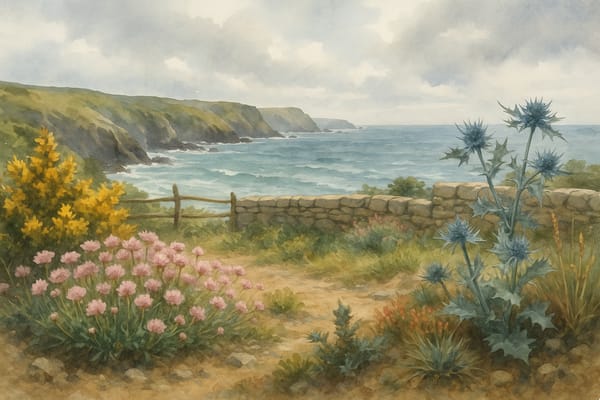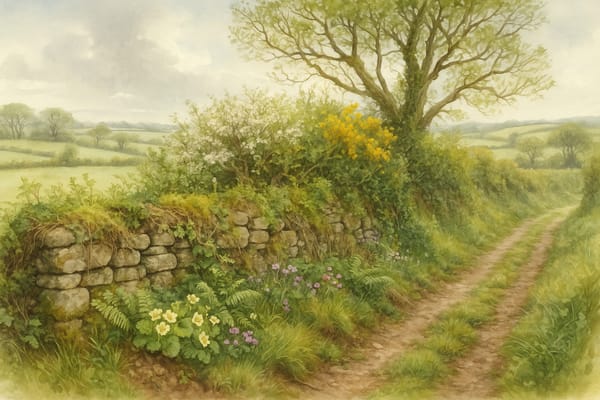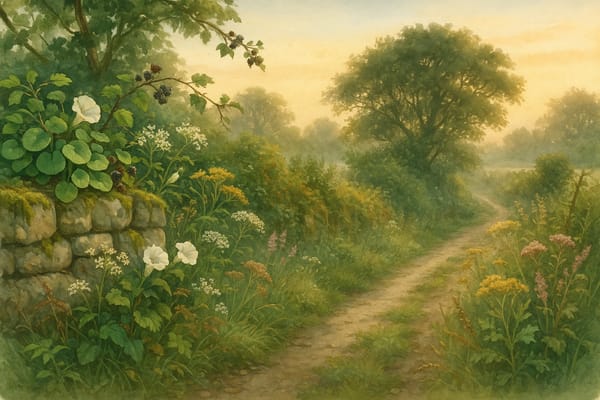Cornwall’s coastline tells a story older than its cliffs. Shaped by the Atlantic’s relentless winds and silver mists, this dramatic landscape has always been a place where nature writes the rules. From ancient field systems bounded by stone and hedge, to the wind-clipped heathlands and craggy outcrops, Cornwall’s coast has long been a canvas of resilience. It is this wild character — unpolished, enduring, alive — that inspires the art of coastal wild gardening.
Gardening here is not about imposing order. It’s about blending with a landscape shaped by storms and softened by sea air. A wild Cornish garden on the coast isn’t something you control; it’s something you nurture, watch, and admire as it grows into its own.
In this special part of the world, the traditional boundaries between cultivated land and wild nature have always been blurred. Old Cornish farms were often edged with hedgebanks alive with thrift, campion, and gorse — natural windbreaks that doubled as wildlife corridors. Fishermen’s cottages, perched on cliffs, embraced hardy plants that could survive both salt spray and neglect. Even the gardens of grander houses like Trelissick and Trebah often showcased exotic species tested by Cornwall’s unique maritime climate.
Today’s coastal wild gardens take cues from this history. They celebrate plants that thrive on adversity — the wind-battered, salt-hardened survivors that form the vibrant tapestry of Cornwall’s natural edge. Hardy perennials like thrift (Armeria maritima), sea holly (Eryngium maritimum), and the golden-blooming gorse (Ulex europaeus) aren’t just decorative; they’re partners in a living system that supports pollinators, stabilises soils, and withstands Cornwall’s famously unpredictable weather.
Imagine a garden where cushions of thrift hug the ground, their pink heads dancing in sea breezes. Where the spiky silver-blue of sea holly stands bold against granite rocks, and where gorse blazes gold in the depths of winter, its flowers offering rare nectar when little else blooms. These plants are more than survivors — they’re storytellers of the coast.
A coastal wild garden works with the land’s rhythms. Instead of manicured lawns, you’ll find self-seeded drifts of sea campion softening stone walls or bird’s-foot trefoil threading through sandy paths. Instead of formal beds, a patchwork of plants arranged by nature — hardy, weather-tolerant, thriving on lean soils without fertilisers or irrigation.
Stone walls and driftwood piles serve dual purpose: defining the garden’s edges while offering shelter to insects, birds, and hedgehogs. And the sea air itself becomes a gardener’s ally, shaping plant forms, pruning naturally, and creating the soft, weathered beauty that feels so right in this setting.
Gorse and blackthorn hedges break the wind’s force and shelter more delicate underplantings, while boulders and gabions echo Cornwall’s mining heritage, now repurposed as wildlife-friendly design features. Gravel paths and sand-edged borders mirror the nearby dunes, inviting a seamless flow between cultivated space and open coast.
What’s most remarkable is how little input a coastal wild garden demands. Watering is rarely needed beyond the first year. Fertilisers are unnecessary — in fact, rich soils can make these hardy natives grow too soft for the wind. Even pruning is occasional, done mainly to refresh growth or manage shape. The garden becomes an evolving partnership between plant, place, and the patient gardener.
This is gardening that invites nature to take the lead. It asks us to slow down, observe, and welcome the shifting tapestry of bloom, seedhead, and sheltering wildlife. A wild garden on Cornwall’s coast isn’t static — it lives and changes with the tides of the seasons.
And perhaps that’s the heart of it: Coastal wild gardening here is more than a style. It’s a reflection of Cornwall itself — resilient, generous, shaped by wind and wave, and always, always alive.











